
Got Grinders? Get Safeguarding
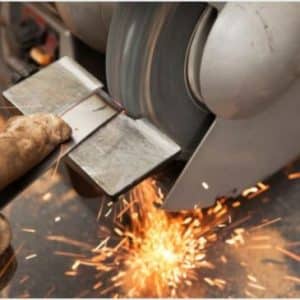 Safeguarding Standards for Bench and Pedestal Grinders
Safeguarding Standards for Bench and Pedestal Grinders
Grinders are one of the most frequently cited machines during OSHA machine-safety inspections. This is frequently due to improperly adjusted work-rests and tongue-guards on bench/pedestal grinders, as well as a lack of ring-testing for the grinding wheels.
OSHA 29 CFR SubPart O 1910.215 is a “machine specific” (vertical) regulation with a number of requirements, which if left unchecked, are often cited by OSHA as violations. ANSI B11.9-2010 (Grinders) and ANSI B7.1 2000 (Abrasive Wheels) also apply.
Work-Rests and Tongue-Guards
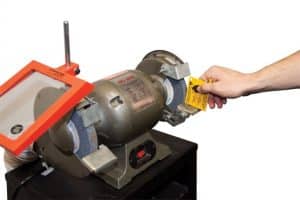 OSHA specifies that work-rests must be kept adjusted to within 1/8-inch of the wheel, to prevent the workpiece from being jammed between the wheel and the rest, resulting in potential wheel breakage. Because grinders run at such a high RPM, wheels actually explode when they break, causing very serious injury, like blindness and even death.
OSHA specifies that work-rests must be kept adjusted to within 1/8-inch of the wheel, to prevent the workpiece from being jammed between the wheel and the rest, resulting in potential wheel breakage. Because grinders run at such a high RPM, wheels actually explode when they break, causing very serious injury, like blindness and even death.
In addition, the distance between the grinding wheel and the adjustable tongue-guard (also known as a “spark arrestor”) must never exceed 1/4-inch. Because the wheel wears down during use, both these dimensions must be regularly checked/adjusted.
“Grinder safety gauges” can be used during the installation, maintenance, and inspection of bench/pedestal grinders to make sure the work-rests and tongue-guards comply with OSHA’s 1910.215 regulation and ANSI standards. Wait until the wheel has completely stopped and the Grinder is properly “Locked Out” before using a “grinder safety gauge”. Grinder coast-down time takes several minutes, which tempts employees to use the “grinder safety gauge” while the wheel is still rotating. This practice is very dangerous because it can cause wheel breakage.
Where grinders are concerned, personal protective equipment (PPE) usually means a full face-shield, not just safety glasses. You cannot be too careful with a machine that operates at several thousand RPM.
Remember, you must DOCUMENT any and all safety requirements set forth by OSHA, as that is their best evidence that safety procedures are really being followed.
Ring-Testing
OSHA says that you must “ring-test” grinding wheels before mounting them to prevent the inadvertent mounting of a cracked grinding wheel.
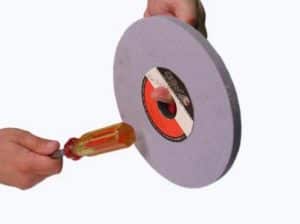 Ring-Testing involves suspending the grinding wheel by its center hole, then tapping the side of the wheel with a non-metallic object. This should produce a bell tone if the wheel is intact. A thud, or a cracked-plate sound indicates a cracked wheel. NEVER mount a cracked wheel.
Ring-Testing involves suspending the grinding wheel by its center hole, then tapping the side of the wheel with a non-metallic object. This should produce a bell tone if the wheel is intact. A thud, or a cracked-plate sound indicates a cracked wheel. NEVER mount a cracked wheel.
For larger grinders, grinding wheels are laid flat on a vibration-table, with sand evenly spread over the wheel. If the wheel is cracked, the sand moves away from the crack.
To prevent cracking a wheel during the mounting procedure, employees must be very carefully trained in those procedures. This starts with making sure the wheel is properly matched to that particular grinder, using proper blotters and spacers, and knowing exactly how much pressure to exert with a torque-wrench, just to mention a few things.
This OSHA-compliant “Wheel-Cover” allows no more than 90 degrees (total) of the wheel left exposed. (65 degrees from horizontal plane to the top of wheel-cover)
Never exceed these wheel-cover maximum opening dimensions. Larger wheel-cover openings create a wider pattern of flying debris should the wheel explode. A well-recognized safety precaution on bench/pedestal grinders is to stand well off to the side of the wheel for the first full minute before using the machine. Accidents have shown that grinding wheels are most likely to shatter/explode during that first minute.
There is an OSHA Instruction Standard #STD 1-12.8 October 30, 1978 addressing the conditional and temporary removal of the “Work Rest” for use only with larger piece parts based on the condition that “Side Guards” are provided. If this may apply to your grinder(s), make sure that you read the entire thing on OSHA.gov.
Safety Information
Grinding Wheels are Safe… Use but Don’t Abuse
Do
Do always Handle and Store wheels in a careful manner
Do Visually Inspect all the wheels before mounting for possible damage
Do Make Sure Operating Speed of machine Does Not Exceed speed marked on wheel, its blotter or container
Do Check Mounting Flanges for equal size, relieved as required & correct diameter
Do Use Mounting Blotters when supplied with wheels
Do be sure Work Rest is properly Adjusted on bench pedestal, and floor stand grinders
Do always Use Safety Guard that covers a minimum of one-half the grinding wheel
Do allow Newly Mounted Wheels to run at operating speed, with guard in place, for at least one minute before grinding
Do always Wear Safety Glasses or some type of approved eye protection while grinding
Do Turn Off Coolant before stopping wheel to avoid creating an out-of-balance condition
Don’t
Don’t use a wheel that has been Dropped or appears to have been abused
Don’t Force a wheel onto a machine Or Alter the size of the mounting hole – If a wheel won’t fit the machine, get one that will
Don’t ever Exceed Maximum Operating Speed established for the wheel
Don’t use mounting flanges on which the bearing surfaces Are Not Clean, Flat And Smooth
Don’t Tighten the mounting nut Excessively
Don’t grind on the Side of conventional, straight or Type 1 wheels
Don’t Start the machine Until the Safety Guard is properly and securely In Place
Don’t Jam work into the wheel
Don’t Stand Directly In Front of a grinding wheel whenever a grinder is started
Don’t grind material for which the Wheel Is Not Designed
Source: Grinding Wheel Institute
Rockford Systems Can Help
Rockford Systems offers a wide variety of safeguarding products for grinders.
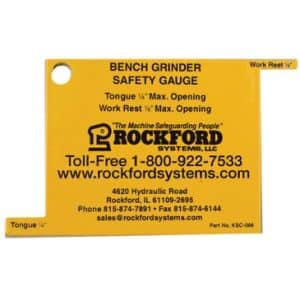 Bench Grinder Safety Gauge
Bench Grinder Safety Gauge
The bench grinder safety gauge is laser-cut, Grade 5052 aluminum with H32 hardness. The safety yellow, durable powder-coated gauge has silk-screened text and graphics. The bench grinder safety gauge measures 2 3/4-inches wide by 2 1/4-inches high by .1000-inches thick and has a 1/4-inch hole for attachment to the bench grinder.
Standard Mount Grinder Shields
These standard mount grinder shields are available in various sizes for protection from the swarf of bench or pedestal grinders. The frames are constructed of reinforced fiber nylon or heavy cast aluminum. Each shield is furnished with a threaded support rod. The transparent portion of the standard mount grinder shields is made of high-impact resistant polycarbonate to minimize scratching and provide durability.
Double-Wheel and Single-Wheel Bench Grinder Shields
Double-wheel bench grinder shields provide protection for both wheels of the grinder with one continuous shield. The durable shield is made of clear, 3/16-inch-thick polycarbonate and measures 18-inch x 6-inch. A special shield bracket adds stability to the top of the shield. The single-wheel bench grinder shield is made of clear, 3/16-inch-thick polycarbonate and measures 6-inch x 6-inch. This sturdy, impact-resistant shield is designed for use when a single wheel needs safeguarding. These shields have a direct-mount base that attaches directly to the grinder table or pedestal.
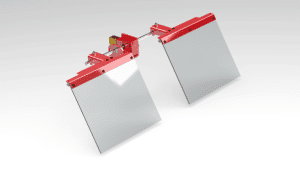 Electrically Interlocked Grinder and Tool Grinder Shields
Electrically Interlocked Grinder and Tool Grinder Shields
These electrically interlocked grinder and tool grinder shields are ideal for single- and double-wheel grinders. When the heavy-duty shield is swung out of position, the positive contacts on the microswitch open, sending a stop signal to the machine control. The safety microswitch electrical wires are furnished with a protective sheath and connect to the safety circuit of the machine that switches off the control to the movement of the grinding wheel. All safety micro switches are mounted in a tamper-resistant NEMA 4 housing with an enclosure rating of IP 67. The multi-adjustable, hexagonal steel arm structure allows easy mounting on the most diverse grinders. A versatile clamp allows horizontal and vertical adjustment of the shield. All electrically interlocked grinder and tool grinder shields consist of a high impact-resistant, transparent polycarbonate shield with an aluminum profile support and provide operator protection from flying chips and coolant.
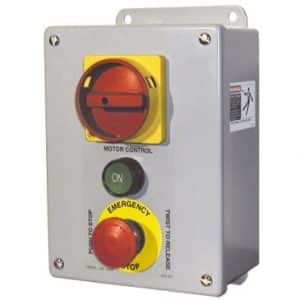 Single-Phase Disconnect Switch and Magnetic Motor Starter
Single-Phase Disconnect Switch and Magnetic Motor Starter
This single-phase unit is designed for motors that have built-in over-loads. Typical applications for these combinations include smaller crimping machines, grinders, drill presses, and all types of saws. The 115-V, 15-A disconnect switch and non-reversing magnetic motor starter are housed in a NEMA-12 enclosure. Enclosure size is 8″ x 6″ x 3 1/2″. It includes a self-latching red emergency-stop palm button and a green motor control start push button. It can be used on machines with 115-V and is rated up to 1/2 HP maximum. The disconnect switch has a rotary operating handle which is lockable in the off position only. This meets OSHA and ANSI standards. For machines with 230-V AC single-phase motors, a transformer is required to reduce the control circuit voltage to 115-V AC in order to comply with NFPA 79.
Danger Sign for Cutting and Turning Machines
Don’t forget to post the appropriate danger signs near all machinery in the plant. The purpose of danger signs is to warn personnel of the danger of bodily injury or death. The suggested procedure for mounting this sign is as follows:
1) Sign must be clearly visible to the operator and other personnel
2) Sign must be at or near eye level
3) Sign must be PERMANENTLY fastened with bolts or rivets
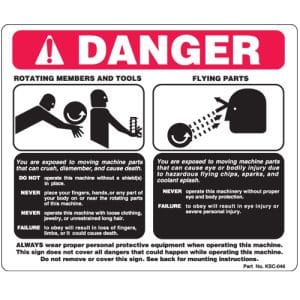
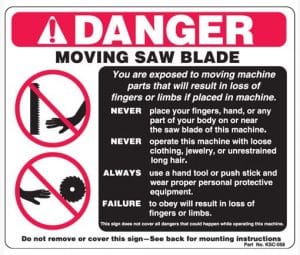
Share this post
Media Contacts
Kari Larson
Rockford Systems, LLC
800-922-7533
[email protected]
Dan O’Connell
O’Connell Communications
708-363-6118
[email protected]
Subscribe to our newsletter
Logo Guidelines
Related Articles
-
An Overview of Perimeter Safeguarding
-
An Overview of Perimeter Safeguarding (Press Release)
-
Rockford Systems Announces Summer Schedule for Online Machine Safeguarding Seminars
-
Rockford Systems Gauge Ensures Machine Safeguarding Meets OSHA, ANSI, and CSA Point-of-Operation Requirements
-
Rockford Systems Donates Safeguarding Machines, Classroom Curriculum Development, and On-site Safety Training to Slippery Rock University
-
Rockford Systems Offers Assistance in Interpreting Recent Changes to OSHA Enforcement Guidance
-
“Zero Force” Optical Touch Button Control System Prevents Repetitive Motion Injuries
-
Rockford Systems Announces New Website Launch
-
What to Do if You are Issued an OSHA Citation
-
Do Your Machines Have Anti-Restart Protection? Here's How to Find Out
-
Rockford Systems Sensing-Saf-Start Protects Machine Operators from Accidental Re-starts following Power Interruptions
-
What The Wave of Retiring Machinists Means to Plant Safety
-
Machine Safeguarding Technology Keep Operators Out of a Pinch
-
Do's and Dont's of Safely Using Bench Grinders
-
Do’s and Don’ts of Safely Using Bench Grinders
-
How Rockford Systems Light Curtains Can Brighten Employee Safety in Your Plant
-
Rockford Systems Introduces Protector Series Light Curtains with Expanded Features
-
Protector™ Series Light Curtains with Expanded Features
-
Surge in Omicron Variant Cases Underscores Continued Need for COVID-19 Shielding
-
Annual Machine Safeguarding Audit Service
-
A Guide to Innovations in Safety Shields: LED lighting, Design Modularity Heighten Operator Protection
-
Machine Guarding Named to OSHA's Top Ten Violations in 2021
-
Training Workshop Addresses Combustion System Safety
-
Pressure-Sensitive Safety Mats Prevent Employee Injuries: Detects presence of workers around hazardous machines
Our Mission
To reduce risk and prevent workplace
injuries by becoming our customer’s trusted
advisor and source for machine safeguarding
training, assessment services, and provider
of turnkey engineered safeguarding solutions.
Location
5795 Logistics Parkway
Rockford Illinois 61109
Phone
1-800-922-7533
Useful Links
Hours of Operation
Copyright 2024. All Rights Reserved By Rockford Systems LLC



